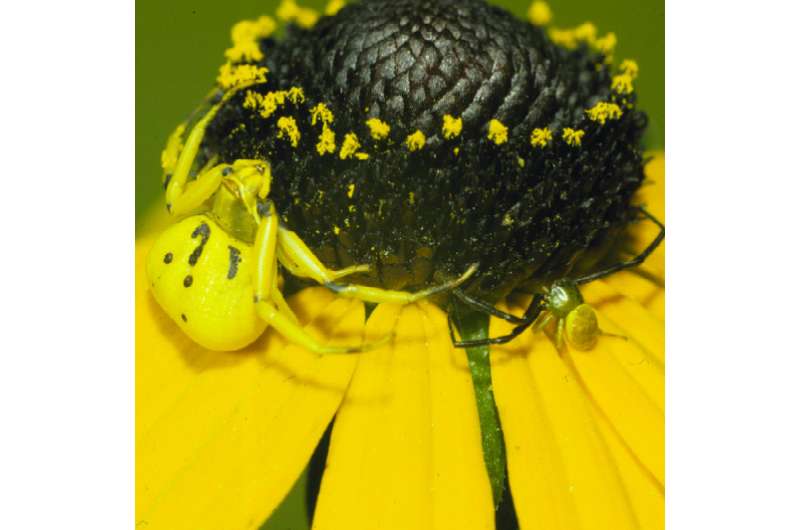Researchers identify spider species able to change colors

A species of crab spider is able to slowly change its color to match its background when hunting, a rare ability in the animal kingdom, says a Ball State University professor.
Gary Dodson, a Ball State biology professor, and Alissa Anderson, who graduated with a master's degree in 2012 from Ball State, were the first to measure the rate of color change in the whitebanded crab spider, an arachnid with the scientific name of Misumenoides formosipes. Anderson is now pursuing her doctorate at the University of Nebraska. Their study was recently published in the journal Ecological Entomology.
As part of the research project, Anderson took digital photos of the crab spider while the white specimens sat on yellow flowers at Ball State's Cooper Farm, an off-campus area with a rich diversity of biological habitats for environmental education and field research.
"This species of spider crab is one of the few that can reversibly change their body color in a manner that to the human eye results in a match to the flowers on which they ambush prey," Dodson said. "We knew that females, but not males, can switch between white and yellow depending on the background. But we did not how quickly that happened."
Researchers used Adobe Photoshop software to collect data on the spiders' ability to change colors, measuring the time it takes for the animal to shift from white to various shades of yellow.
However, they discovered that it was more difficult for yellow crab spiders to match their white background as opposed to their white counterparts. A possible answer is that morphing from white to yellow is less physiologically damaging than the reverse.
Dodson also pointed out that this species of crab spider exhibits one of the most extreme examples of sexual size dimorphism across all animals. Females, which are the size of a "fat kernel of corn," are 20 times larger in mass than males. The small males become adults prior to females and then go searching for mates through a physically complex habitat.
"Acrobatic skills are critical as they must do a lot of climbing and bridging—scrambling across silk lines sent across gaps between plants," Dodson said. "They can't see the females, yet they find them at a rate that random searching could not explain. We documented that the males will optimize their searches by moving toward the odor of a flower species on which sedentary females hunt for prey."
He also found that male crab spiders outnumber females and multiple suitors will gather around females close to becoming adults. The males often get in fights that result in the loss of limbs and sometimes death.
"We determined that first to arrive, body size and previous contest experience are predictors of who will win the fights and remain close to the female," Dodson said. "We also were able to document another surprising behavior for these spiders—that the males drink nectar. This has since been determined for several other species. Overall, it has been a fascinating animal to study."
More information: ANDERSON, A. G., & DODSON, G. N. (2014). Colour change ability and its effect on prey capture success in female Misumenoides formosipes crab spiders . Ecological Entomology, 40(2), 106–113. DOI: 10.1111/een.12167
Journal information: Ecological Entomology
Provided by Ball State University



















